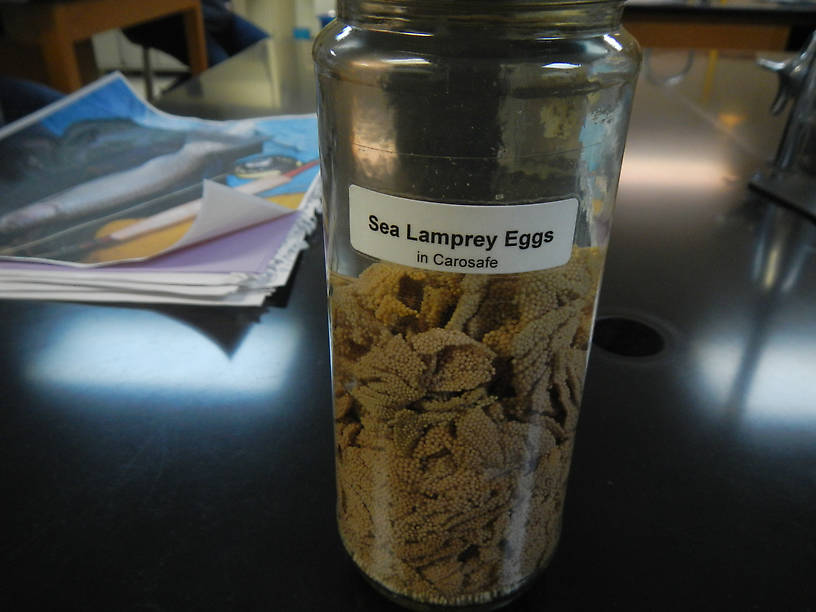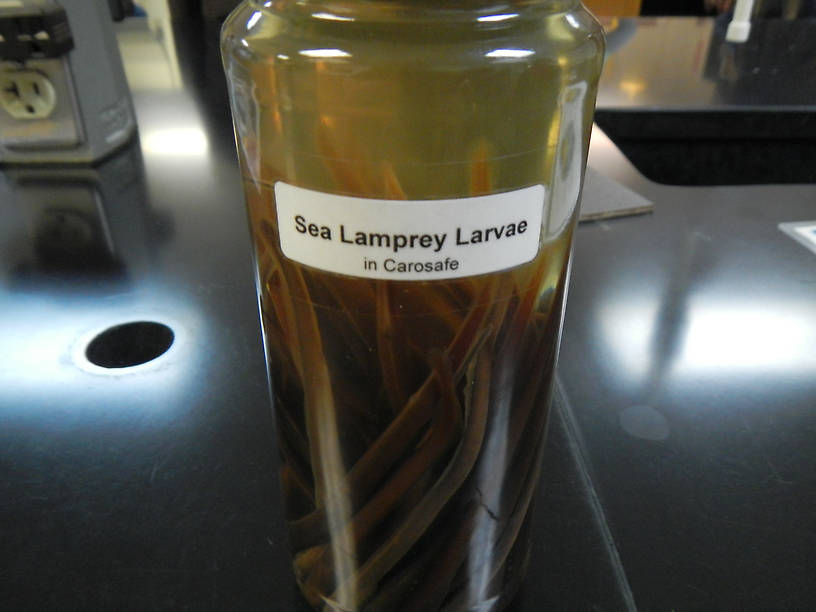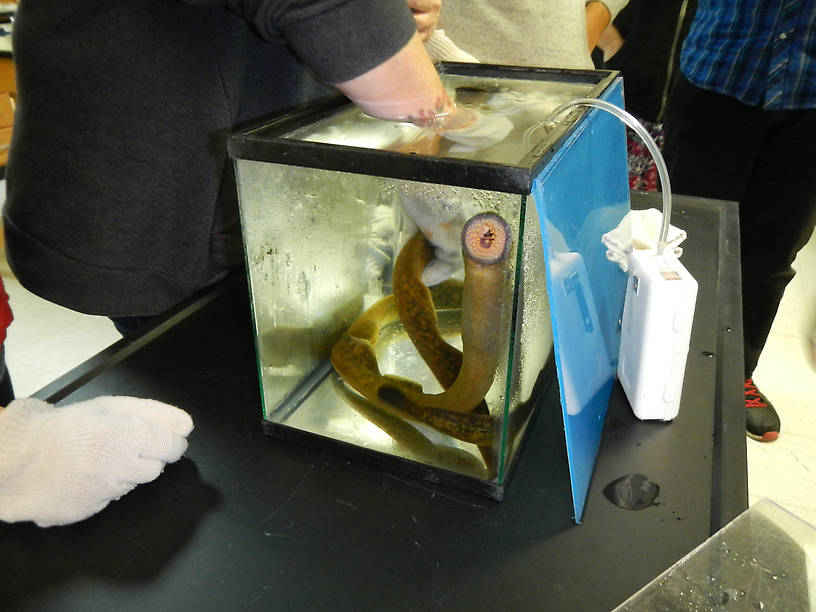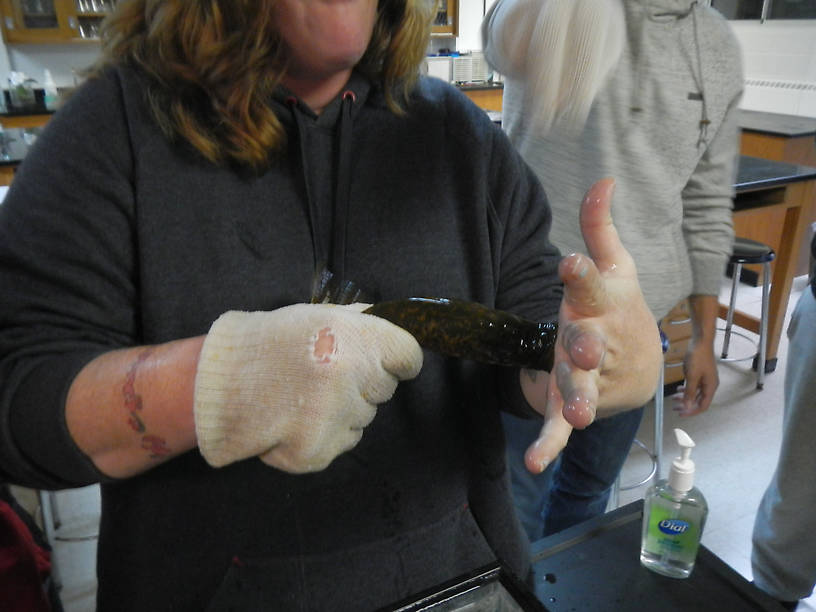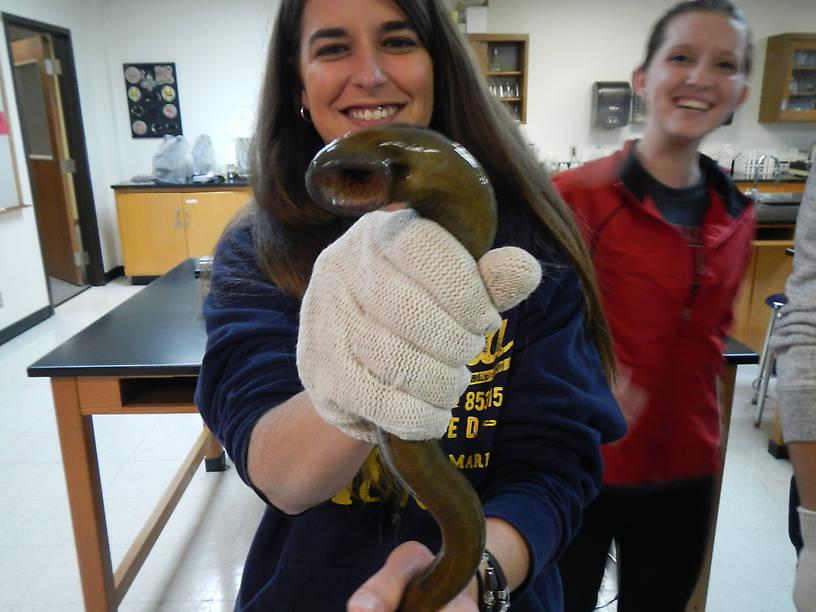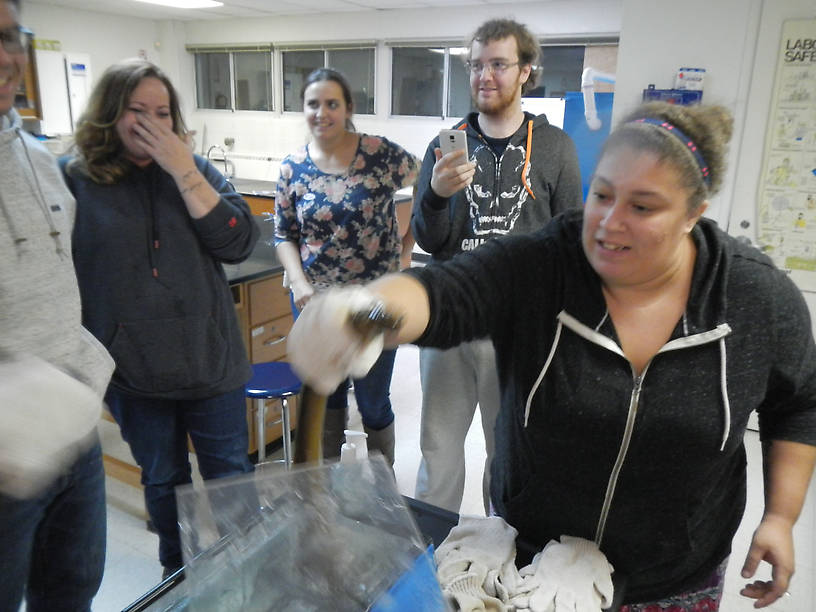Blog & Latest Updates
Fly Fishing Articles
Insects by Common Name


> > Lampreys!! Eeeew...but fascinating, and (almost) cute
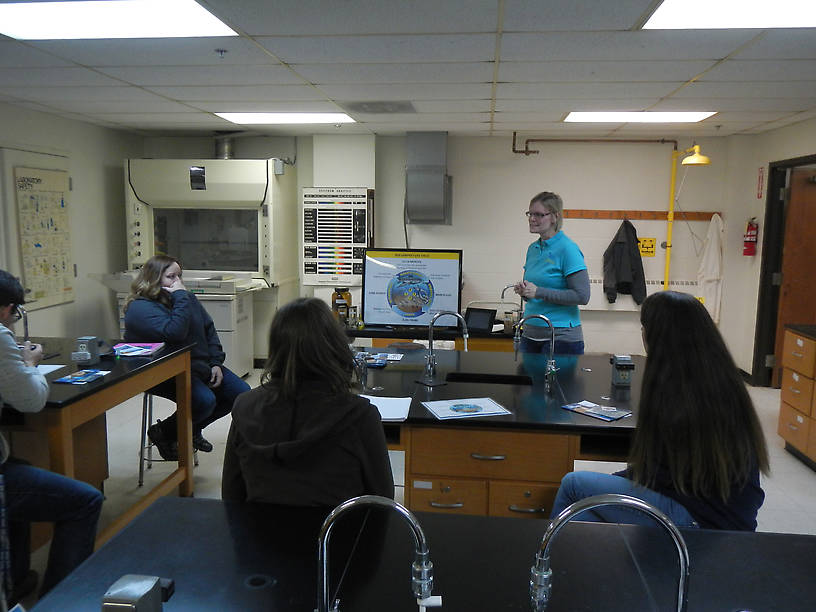
Dr. Andrea Miehls discussing the life cycle of sea lamprey in the Great Lakes
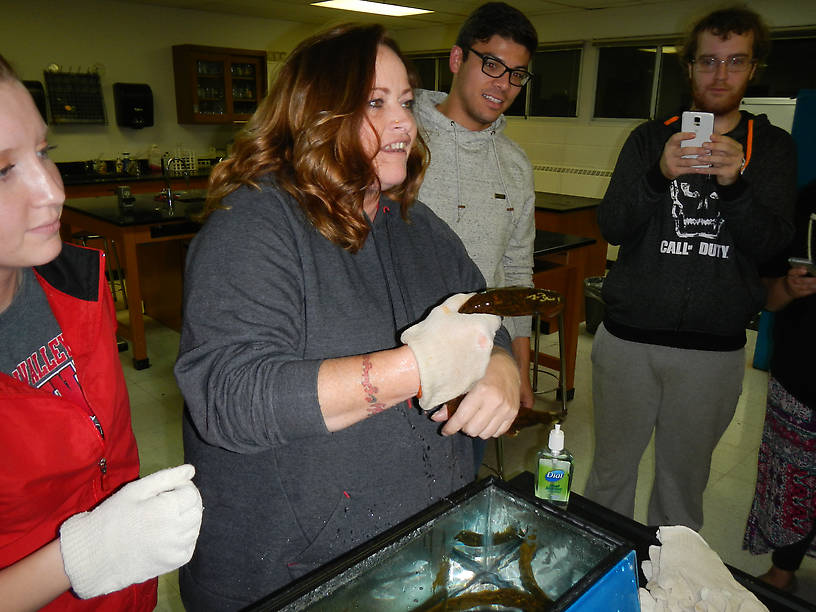
Laurie, veteran of both the U.S. Army AND Field Biology, is of course the first
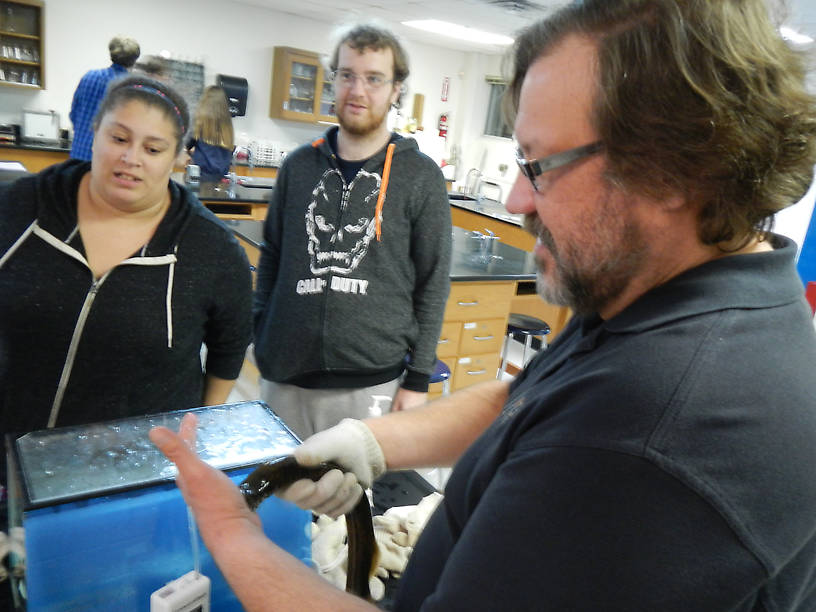
Since they attach with 3-4 times the suction of the average vacuum cleaner, I'm VERY happy they don't bite people!! I have enough issues with leeches...
| Jmd123 | November 9th, 2016, 4:11 pm | |
| Oscoda, MI Posts: 2611 | Yesterday I got lucky and didn't have to teach! Instead, I turned my class over to Dr. Andrea Miehls, who does research at the Hammond Bay Biological Station, an institution of the USFW Service who's sole purpose is to study the biology and control of the sea lamprey in the Great Lakes. Not only did she have ample graphic aids and preserved specimens of all of the lamprey's life stages, we got to handle live lampreys ourselves! Slimy creatures, we handled them with at least one cotton glove on to avoid dropping them on the floor - they may be nasty invasive parasites, but they're still living creatures. I wouldn't call them pretty, but they are kinda cute in a foul parasitic way...in any case, Dr. Miehls says that lampreys are about 90% controlled these days, great news for those of us who like to catch and eat lake trout! Especially as one lamprey will kill 40 POUNDS of fish during it's lifetime...and these days lakers aren't all that uncommon in these parts. Gonna get one on the 8 weight, one day when I can stand to be out in my kayak while the waters are cold enough for them to be within fly-fishable depth. Bundled up no doubt! As you can see, the students had a ball, and so did I! Jonathon | |
| No matter how big the one you just caught is, there's always a bigger one out there somewhere... | ||
| Partsman | November 11th, 2016, 1:48 pm | |
| bancroft michigan Posts: 420 | cool, saw one up in the rifle this past spring, at least that's what I thought it was. The first one I ever saw was back in the 70s my greataunt lived on the west branch of the pine river and spent a lot of time fishing the river, she caught one of these for us kids to study. | |
| Martinlf | November 13th, 2016, 4:10 pm | |
Moderator Palmyra PAPosts: 3233 | Wow. | |
| "He spread them a yard and a half. 'And every one that got away is this big.'" --Fred Chappell | ||
| Oldredbarn | November 16th, 2016, 2:03 pm | |
| Novi, MI Posts: 2608 | Really good post Jonathon! She say anything about the four others that are native here to the Great Lakes? We caught a Brown in the Manistee this past summer that had a Chestnut lamprey on it, and it let go as soon as the fish left the river... Chestnut, Northern Brook, Silver, American Brook are the other four. Looks like an interesting class. Just got back from Indiana this past weekend. Went with the Oakland Audubon chasing Whooping Cranes down at Goose Pond NWA near Terra Haute. Had four fly right over our heads! A life bird for me...I think there are less than 500 wild birds left. Also got a Carolina Chickadee which is very close to our Black-capped. Also a lifer. My wife actually got up at 4:00am so we could be in the field before sunup, in 26 degree weather, to watch a few thousand Sandhills leave their roost in the morning and spread out to forage for the day. We were at Jasper-Pulaski NWA. Got some great pics! Spence | |
| "Even when my best efforts fail it's a satisfying challenge, and that, after all, is the essence of fly fishing." -Chauncy Lively "Envy not the man who lives beside the river, but the man the river flows through." Joseph T Heywood | ||
| Jmd123 | November 19th, 2016, 11:35 am | |
| Oscoda, MI Posts: 2611 | Hey Spence, sorry it took me a while to get back to you on your question of the native lampreys. According to Dr. Miehls, it is the SIZE of the parasite relative to it's host that is the problem. In the ocean, sea lampreys parasitize larger fish like tuna, mackerel, billfish, etc. and are too small to actually do any harm to their hosts, other than leaving an itchy spot! (I just noticed that I can STILL see the leech bite on my leg I got on the Pine back in August...) Now, they grow bigger in the ocean, like up to 2 1/2 feet long, but still considering the size of their hosts they don't really cause much of a problem. Despite the fact that they don't get that big in the Great Lakes (specimens above are average-sized), they are still MUCH larger in terms of size compared to their newfound hosts, e.g., lake trout. She said, "Imagine a parasite the size of a BASEBALL BAT hanging off of you, sucking your blood. You wouldn't live very long, would you??" So, the native lampreys are just little guys, and only the silver and chestnut are parasitic. They don't kill their hosts either, because they EVOLVED with them, the problem with the sea lamprey being INVASIVE. Brook lampreys don't feed as adults at all, they simply live for about a month, long enough to mate, lay eggs, and die. And they ARE actually kind of cute, I shocked up a lot of western brook lampreys when I worked at South Slough Reserve on the Oregon coast. Classic lesson about the harm invasives can do. Jonathon | |
| No matter how big the one you just caught is, there's always a bigger one out there somewhere... | ||
| PaulRoberts | December 10th, 2016, 5:38 am | |
| Colorado Posts: 1776 | Great info on lamprey's Jonathan, and a good example of the risks of invasives. | |
Quick Reply
You have to be logged in to post on the forum. It's this easy:
Related Discussions
| Title | Replies | Last Reply |
| Re: Lampetra fluviatilis ? In General Discussion by Falsifly | 10 | Jun 1, 2009 by Martinlf |
| Re: Pictures and specimens from my 2018 Montana trip In Site Updates by Troutnut | 7 | Jun 25, 2019 by Wbranch |
| Re: SE Minnesota In General Discussion by HighFlyer | 6 | Aug 15, 2008 by HighFlyer |
| Re: Lower Rondout Stream In General Discussion by Arko | 4 | Feb 18, 2013 by Troutnut |
| Re: River Wharfe In Fishing Reports by CaseyP | 1 | Sep 27, 2009 by Martinlf |
| Re: Lamprey Fly Patterns In General Discussion by GWT | 2 | Dec 7, 2021 by Partsman |
| Re: Grout Brook In General Discussion by Al514 | 2 | Oct 8, 2007 by Al514 |
| Re: Catskills/Sullivan Co.,NY In the Photography Board by Bluemoon | 3 | Feb 22, 2011 by Troutnut |
| Re: General Questions In Gear Talk by TedderX | 3 | May 23, 2016 by CaseyP |
| Re: New In Fly Fishing In Beginner Help by Alaxpol | 6 | Dec 24, 2018 by Iasgair |
Troutnut.com is copyright © 2004-2024 Jason
Neuswanger (email Jason). See my FAQ for information about use of my images.
 privacy policy
privacy policy

